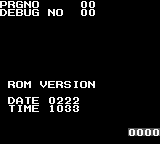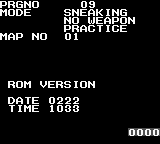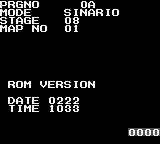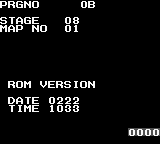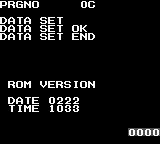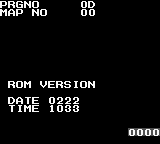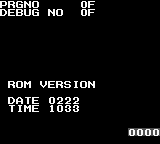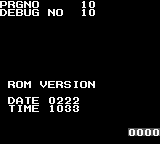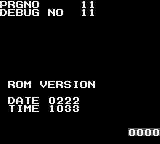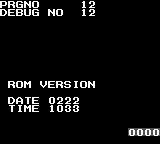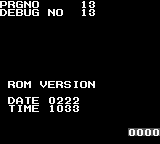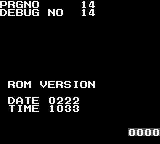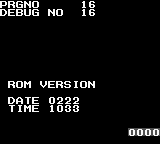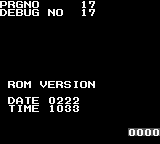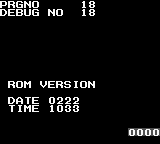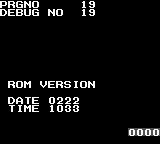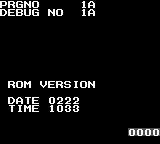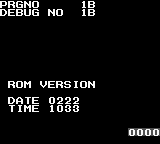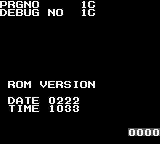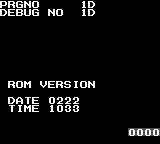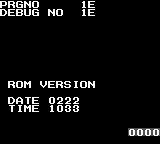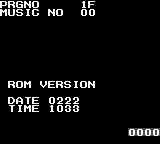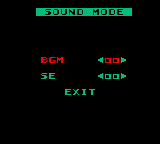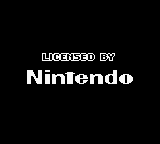Metal Gear Solid (Game Boy Color)
| Metal Gear Solid |
|---|
|
Also known as: Metal Gear: Ghost Babel (JP)
|
A 2D adaptation of Metal Gear Solid, which itself was already a 3D adaptation of Metal Gear and its sequel. Unlike the earlier NES games in the series, Kojima actually had some involvement in this one as a producer.
| To do: Possible anti-piracy startup screen? (Sighted around the year of release on NO$GMB) |
Contents
Sub-Page
| Notes |
Debug Menu
Game Genie code 001-87F-B32 or GameShark code 01000AC4 will start all versions of the game in a rather comprehensive debug menu. It includes a sound test, cutscene viewer, the ability to fly to any VR Mission, and a plethora of other options.
Press Left or Right to browse through the menus, and press Down or A to make a selection. Pressing B will return to the previous selection.
Build Dates
| Japan | North America | Europe |
|---|---|---|
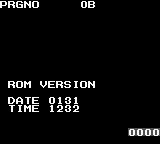
|
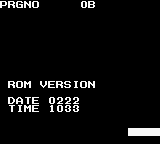
|
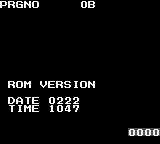
|
The build dates for each version can be seen on the game's debug screen. The Japanese version was compiled on January 31 at 12:32, while the American and European versions were both compiled 15 minutes apart on February 22 at 10:33 and 10:47 respectively.
Sound Test
| Japan | U.S./Europe |
|---|---|
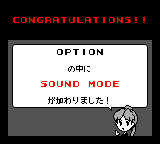 |
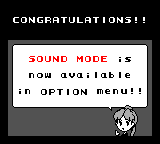 |
Under normal circumstances, the sound mode can only be accessed after finishing all VR missions in the game in both practice and time attack mode. However, it can be enabled earlier through the debug menu using a Game Genie or Game Shark.
| Japan/U.S. | Europe |
|---|---|
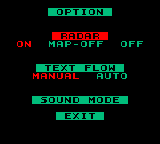 |
 |
In the Sound Mode, use the Control Pad to navigate through the BGM and SE list. Press A to play the track or sound effect, and B to stop the music.
Regional Differences
Title
| Japan | North America | Europe |
|---|---|---|

|
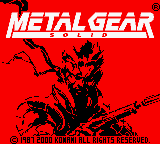
|
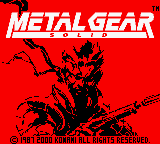
|
The Japanese version takes the Metal Gear Solid logo, blanks out the "Solid" and adds the subtitle Ghost Babel underneath (which conveniently shares the same initials as the Game Boy) in an attempt to give the game its own identity, whereas the other versions just left it as is. Because of this, the logo in the Japanese version is positioned slightly differently. Note that the American version is the only one with a registered trademark.
A "Licensed by Nintendo" screen was also added to the American and European versions prior to the Konami logo when the game starts.
Language Settings
| Japan/U.S. | Europe |
|---|---|
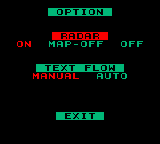 |
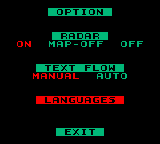 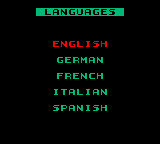 |
The European version features support for five different languages accessible from the options screen, with English serving as the default setting. These menus are actually present in the code for the Japanese and American version, but they were not implemented since they only contain one version of the script each. The European version actually has the entire Japanese script as well within the code, but it's inaccessible by normal means.
Radar
| Japanese | English |
|---|---|
The on-screen indicators for the radar were appropriately localized. Both sets of indicators are actually stored in all three versions of the game.
IdeaSpy 2.5
IdeaSpy 2.5 is a story within a story that is unlocked in the Japanese and European versions from the second playthrough and onward. It's presented as an in-game radio drama, accessible by going to the codec screen and dialing frequency number 140.07. The story is divided into 13 episodes, one for each stage of the game.
This story was also meant to be present in the American version, but was not fully implemented due to insufficient ROM space - a huge chunk of the script is actually contained within the American ROM starting at 0x1FC000, but gets cut-off at offset 0x1FF27A, ending abruptly with the beginning of Episode 8. As a result, the frequency number was disabled in the American version and Shuyo Murata's (the author) entry in the ending credits was removed as well. The European version, which uses a 32-megabit ROM size (in order to support the multiple languages settings besides English) instead of the 16-megabit ROM used by the other versions, didn't have to deal with such space constraints and as such the entire story is fully present in all five supported languages.
The Metal Gear series
| |
|---|---|
| MSX2 | Metal Gear • Metal Gear 2: Solid Snake |
| NES | Metal Gear • Snake's Revenge |
| DOS | Metal Gear |
| Metal Gear Solid | |
| PlayStation | Metal Gear Solid (Prototype) |
| Game Boy (Color) | Metal Gear Solid |
| PlayStation 2 | Metal Gear Solid 2: Sons of Liberty (Prototype) • Metal Gear Solid 3: Snake Eater (Prototype) |
| PlayStation 3 | Metal Gear Solid 4: Guns of the Patriots |
| Windows | Metal Gear Solid 2: Substance • Metal Gear Solid V: Ground Zeroes • Metal Gear Solid V: The Phantom Pain |
| PlayStation Portable | Metal Gear Solid: Portable Ops • Metal Gear Solid: Portable Ops Plus • Metal Gear Solid: Peace Walker |
| Nintendo 3DS | Metal Gear Solid: Snake Eater 3D |
| Other | |
| PlayStation Portable | Metal Gear Acid 2 |
| Windows, PlayStation 3, Xbox 360 | Metal Gear Rising: Revengeance (Prototype) |
| GameCube | Metal Gear Special Disc |
- Pages missing developer references
- Games developed by TOSE
- Games developed by Konami Computer Entertainment Japan
- Pages missing publisher references
- Games published by Konami
- Game Boy Color games
- Pages missing date references
- Games released in 2000
- Games released in April
- Games released on April 27
- Games released on April 24
- Games released in May
- Games released on May 5
- Games with debugging functions
- Games with hidden sound tests
- Games with hidden level selects
- Games with regional differences
- To do
- Metal Gear series
Cleanup > Pages missing date references
Cleanup > Pages missing developer references
Cleanup > Pages missing publisher references
Cleanup > To do
Games > Games by content > Games with debugging functions
Games > Games by content > Games with hidden level selects
Games > Games by content > Games with hidden sound tests
Games > Games by content > Games with regional differences
Games > Games by developer > Games developed by Konami > Games developed by Konami Computer Entertainment Japan
Games > Games by developer > Games developed by TOSE
Games > Games by platform
Games > Games by publisher > Games published by Konami
Games > Games by release date > Games released in 2000
Games > Games by release date > Games released in April
Games > Games by release date > Games released in April > Games released on April 24
Games > Games by release date > Games released in April > Games released on April 27
Games > Games by release date > Games released in May
Games > Games by release date > Games released in May > Games released on May 5
Games > Games by series > Metal Gear series
The Cutting Room Floor > Unimportant Awards > Game Boy games > Game Boy Color games
